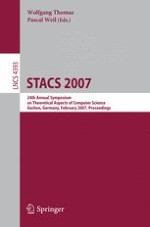2007 | Buch
STACS 2007
24th Annual Symposium on Theoretical Aspects of Computer Science, Aachen, Germany, February 22-24, 2007. Proceedings
herausgegeben von: Wolfgang Thomas, Pascal Weil
Verlag: Springer Berlin Heidelberg
Buchreihe : Lecture Notes in Computer Science
